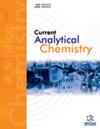硅基 1,3-二苯基-1,3-丙二酮复合材料:用于环境修复的高效铀捕获
IF 1.7
4区 化学
Q3 CHEMISTRY, ANALYTICAL
引用次数: 0
摘要
简介::本研究合成了一种新型混合复合材料 SGdpm,并对其进行了表征,以捕获水中的二氧化铀 2+ 离子。这种复合材料是通过在无机硅胶基质中共价承载二苯基甲烷-1,3-二酮(dpm)而成功形成的,在环境修复和核废料管理方面具有广阔的应用前景。制备方法制备过程包括四乙基正硅酸盐(TEOS)与二苯基甲烷-1,3-二酮(dpm)在酸性条件下发生反应,生成白色固体。傅立叶变换红外光谱(FTIR)对掺杂的复合材料进行了表征,发现其中存在硅氧烷和 Si-O-C 键。研究了 SG-dpm 在从水中捕获 UO2 2+ 离子方面的应用,结果表明傅立叶变换红外光谱峰发生了移动,并证实形成了 SG-dpm-UO2 2+ 内球复合物。扫描电子显微镜(SEM)显示了颗粒的不均匀分布,这对于吸附等应用中的一致行为至关重要。结果与讨论批量吸附实验表明,吸附行为与温度有关,温度越高(T = 55 °C),吸附效率越高。研究还探讨了 pH 值和初始浓度对 UO2 2+ 吸附的影响,结果表明在 pH 值为 5 和较低的初始浓度(1.0 毫克/升)条件下吸附效果最佳。使用伪二阶模型进行的动力学研究表明,作为一种化学吸附过程,UO2 2+ 离子的去除效率很高(99%)。颗粒内扩散模型强调了三个不同的吸附阶段。吸附等温线研究倾向于采用 Langmuir 模型,强调单层吸附。热力学分析表明这是一个内热(ΔH = + 16.120 kJ mol-1)和自发(ΔG = -25.113 至 - 29.2449 kJ mol-1)的吸附过程。选择性研究表明,对 Cu2+、Co2+ 和 Cr3+ 离子的捕获效率高,对 UO2 2+ 离子的选择性高(74%),对 Fe3+ 和 Zn2+ 的捕获效率中等,对 Pb2+、Ni2+ 和 Cd2+ 的捕获效率较低,对 Mn2+ 离子的捕获效率较低。总之,SG-dpm 在选择性去除 UO2 2+ 离子方面表现出了巨大的潜力,为包括环境修复和核废料管理在内的各种应用提供了有利的特性。本文章由计算机程序翻译,如有差异,请以英文原文为准。
Silica-Based 1,3-Diphenyl-1,3-Propanedione Composites: Efficient Uranium Capture for Environmental Remediation
Introduction:: This study synthesizes and characterizes a novel hybrid composite, SGdpm, to capture UO2 2+ ions from water. The composite has successfully formed by hosting covalently diphenylmethane-1,3-dione (dpm) within an inorganic silica gel matrix, showing promising potential for environmental remediation and nuclear waste management. Methods:: The preparation involved the reaction of tetraethylorthosilicate (TEOS) with diphenylmethane- 1,3-dione (dpm) under acidic conditions, resulting in white solids. The doped composite was characterized by Fourier Transform Infrared Spectroscopy (FTIR), revealing the presence of siloxane and Si-O-C bonds. The application of SG-dpm for capturing UO2 2+ ions from water was investigated, showing a shift in FTIR peaks and confirming the formation of SG-dpm-UO2 2+ as inner-sphere complexes. Scanning Electron Microscopy (SEM) revealed a non-uniform distribution of particles, essential for consistent behavior in applications such as adsorption. Results and Discussion:: Batch sorption experiments demonstrated temperature-dependent sorption behavior with increased efficiency at higher temperatures (T = 55 °C). The study also explored the influence of pH and initial concentration on UO2 2+ sorption, revealing optimal conditions at pH 5 and lower initial concentrations (1.0 mg L-1). Kinetic studies using pseudo-second-order models indicated a high efficiency of UO2 2+ ion removal (99 %) as a chemisorption process. Intraparticle diffusion models highlighted three distinct sorption stages. Sorption isotherm studies favored the Langmuir model, emphasizing monolayer adsorption. The thermodynamic analysis suggested an endothermic (ΔH = + 16.120 kJ mol-1) and spontaneous (ΔG = −25.113 to − 29.2449 kJ mol-1) sorption process. Selectivity studies demonstrated high efficiency in capturing Cu2+, Co2+, and Cr3+ ions, high degree selectivity of UO2 2+ ions (74 %), moderate efficiency for Fe3+ and Zn2+, and lower efficiency for Pb2+, Ni2+, and Cd2+, and poor efficiency for Mn2+ ions. In Conclusion,: SG-dpm exhibits promising potential for selective UO2 2+ ion removal, demonstrating favorable characteristics for various applications, including environmental remediation and nuclear waste management.
求助全文
通过发布文献求助,成功后即可免费获取论文全文。
去求助
来源期刊

Current Analytical Chemistry
化学-分析化学
CiteScore
4.10
自引率
0.00%
发文量
90
审稿时长
9 months
期刊介绍:
Current Analytical Chemistry publishes full-length/mini reviews and original research articles on the most recent advances in analytical chemistry. All aspects of the field are represented, including analytical methodology, techniques, and instrumentation in both fundamental and applied research topics of interest to the broad readership of the journal. Current Analytical Chemistry strives to serve as an authoritative source of information in analytical chemistry and in related applications such as biochemical analysis, pharmaceutical research, quantitative biological imaging, novel sensors, and nanotechnology.
 求助内容:
求助内容: 应助结果提醒方式:
应助结果提醒方式:


